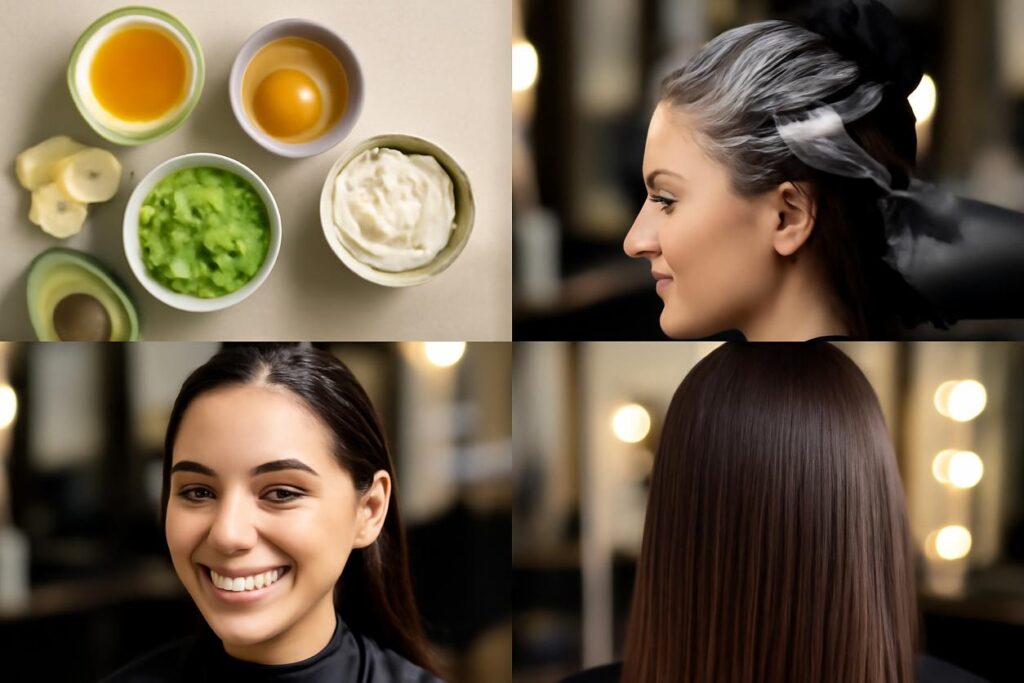The Ultimate Guide to Hair Health: A Scalp-First Approach for 2025
Table of Contents
- Introduction: Rethinking Hair Health
- How Hair Grows — The Essentials
- Scalp Health: A Hands-on Primer
- Key Nutrients for Strong Hair
- Practical Daily Routine
- Weekly Rituals for Deep Care
- Styling Habits That Protect Hair
- Reading Labels: What Ingredients Help or Harm
- Troubleshooting: Breakage, Thinning, Frizz
- A Realistic 4‑Week Hair Health Plan
- When to Seek Clinical Advice
- FAQs
- Further Reading and Rich Hair UK Resources
- Wrap-up: Small Changes, Lasting Results
Introduction: Rethinking Hair Health
In a world of endless miracle products and complicated 10-step routines, the path to vibrant, strong hair can feel overwhelming. We’re often told that the secret lies in the next bottle we buy, but true, lasting hair health begins long before a product touches your strands. It starts at the root—literally. This guide shifts the focus from masking problems to building a foundation of wellness from the inside out and the scalp up.
Forget the quick fixes and marketing gimmicks. We’re embracing a holistic, scalp-first philosophy that combines evidence-led nutrition, mindful styling, and sustainable habits. This comprehensive guide is designed for anyone ready to invest in their hair health for the long term. By understanding the fundamentals of how your hair grows and what it truly needs, you can build a simple, effective routine that delivers visible, lasting results.
How Hair Grows — The Essentials
To nurture your hair, it helps to understand its lifecycle. Each strand on your head grows from a follicle, a tiny pocket in your scalp. The hair growth process is a continuous cycle with three main phases:
- The Anagen (Growing) Phase: This is the active growth phase, where cells in the hair bulb divide rapidly to create new hair. This phase can last anywhere from two to seven years. The length of your anagen phase determines the maximum length your hair can reach.
- The Catagen (Transition) Phase: A short, transitional phase lasting about two to three weeks. During this time, hair growth stops, and the outer root sheath shrinks and attaches to the root of the hair, forming what is known as a club hair.
- The Telogen (Resting) Phase: This is the final phase, lasting around three months. The hair follicle is completely at rest, and the club hair is fully formed. At the end of this phase, the hair is shed, and the cycle begins again with a new hair growing in its place.
Since every strand is born in the scalp, a healthy, well-nourished scalp environment is non-negotiable for a strong anagen phase and overall robust hair. This is why a scalp-first approach is the most logical path to excellent hair health.
Scalp Health: A Hands-on Primer
Think of your scalp as the garden where your hair grows. If the soil isn’t healthy, the plants won’t thrive. Product buildup, inflammation, poor circulation, and dryness can all hinder follicle function and compromise hair growth.
The Scalp Microbiome
Just like your gut, your scalp has a unique ecosystem of microorganisms called the scalp microbiome. When this system is balanced, it protects against irritation, dandruff, and other issues. Harsh cleansers and infrequent washing can disrupt this delicate balance. The goal is to keep it clean but not stripped, allowing the beneficial microbes to flourish.
Cleansing 101
Washing your hair is the primary way you care for your scalp. The key is to find the right balance for your hair type.
- Frequency: This varies. Oily scalps may need washing every 1-2 days, while dry or coily hair types might go 3-7 days or more. Pay attention to how your scalp feels—if it’s itchy, flaky, or greasy, it’s time to wash.
- Technique: Use your fingertips (not nails!) to gently massage shampoo directly onto the scalp. Focus the cleansing effort there, and let the suds run down your hair strands to clean them.
- Temperature: Use lukewarm water. Hot water can strip the scalp of its natural oils, leading to dryness or rebound oil production.
The Power of Massage
A simple scalp massage is a powerful tool for boosting hair health. Massaging your scalp for just a few minutes a day can increase blood flow to the follicles, delivering more oxygen and essential nutrients needed for growth. It’s also a fantastic way to relieve stress, which is a known contributor to hair issues.
Key Nutrients for Strong Hair
You can’t build a strong house with poor materials, and the same goes for your hair. Hair is primarily made of a protein called keratin. A balanced diet rich in specific vitamins and minerals is the ultimate foundation for producing strong, resilient hair strands. For a deeper dive into diet, explore these fundamentals of Hair Nutrition.
| Nutrient | Why It’s Important for Hair Health | Food Sources |
|---|---|---|
| Protein (Amino Acids) | The literal building block of hair (keratin). A deficiency can lead to brittle, weak hair. | Lean meats, fish, eggs, dairy, legumes, tofu, quinoa. |
| Iron | Helps red blood cells carry oxygen to your follicles. Low iron (anemia) is a major cause of hair loss. | Red meat, spinach, lentils, chickpeas, fortified cereals. |
| Biotin (Vitamin B7) | Aids in keratin production. While deficiency is rare, ensuring adequate intake supports hair strength. | Eggs (cooked), almonds, salmon, sweet potatoes. |
| Zinc | Plays a crucial role in hair tissue growth and repair. It also helps keep the oil glands around the follicles working properly. | Oysters, beef, pumpkin seeds, lentils. |
| Vitamin C | A powerful antioxidant that helps create collagen and aids in iron absorption. | Citrus fruits, strawberries, bell peppers, broccoli. |
| Omega-3 Fatty Acids | Nourishes follicles, promotes scalp circulation, and adds shine and elasticity. | Salmon, mackerel, chia seeds, flaxseeds, walnuts. |
Practical Daily Routine
Your daily habits have a cumulative impact on your hair. Small, consistent actions are more effective than occasional intensive treatments.
Gentle Detangling
Hair is most fragile when wet. To prevent breakage, avoid aggressive brushing right out of the shower. Instead, use a wide-tooth comb or your fingers to gently detangle, starting from the ends and working your way up to the roots. This method prevents you from pulling a knot tighter and ripping through the hair strand.
Hydrate from Within
Proper hydration is essential for overall health, and that includes your scalp and hair. Dehydration can lead to a dry scalp and brittle hair. Aim to drink plenty of water throughout the day to support cellular function from head to toe.
Weekly Rituals for Deep Care
Set aside time once a week to give your hair a little extra attention. This is about deep nourishment and resetting your scalp environment.
Deep Conditioning Treatment
A weekly deep conditioner or hair mask helps replenish moisture and strengthen the hair cuticle. You can use a store-bought mask or create a simple DIY version with ingredients like avocado, honey, or coconut oil. Apply it to clean, damp hair, leave it on for 20-30 minutes, and then rinse thoroughly.
Clarifying Scalp Treatment
Over time, products, natural oils, and hard water minerals can build up on the scalp, clogging follicles. A gentle clarifying treatment can remove this buildup. A simple, diluted apple cider vinegar rinse (1 part ACV to 4 parts water) applied after shampooing can help restore your scalp’s pH balance and add shine. Use this no more than once or twice a month to avoid over-stripping.
Styling Habits That Protect Hair
How you style your hair is just as important as how you clean and feed it. Many common hair issues, like breakage and split ends, are caused by mechanical damage from styling.
Heat Styling Smarter
High heat is one of the biggest enemies of good hair health. To minimize damage, always apply a heat protectant spray first. Whenever possible, use the lowest effective temperature setting on your tools. Investing in tools with ceramic or tourmaline plates can also help distribute heat more evenly.
Low-Tension Styles
Consistently wearing tight hairstyles like high ponytails, tight braids, or buns can put constant strain on your hair follicles. This can lead to a type of hair loss called traction alopecia. Opt for looser styles, and try to vary your hairstyle from day to day to give your follicles a break. For more ideas, check out these Styling Tips.
Protective Sleep Habits
The friction from tossing and turning on a cotton pillowcase can cause frizz and breakage. Switching to a silk or satin pillowcase provides a smoother surface for your hair to glide over. Alternatively, loosely braiding your hair or putting it in a loose bun on top of your head can also prevent tangles and damage overnight.
Reading Labels: What Ingredients Help or Harm
Navigating the ingredient list on hair products can be confusing. Focusing on a few key types of ingredients can help you make better choices. Learn more about product selection with these Haircare Basics.
Ingredients to Look For
- Humectants: These ingredients attract moisture. Look for glycerin, hyaluronic acid, and panthenol.
- Emollients: These smooth the hair cuticle and add softness. Natural oils like argan oil, jojoba oil, and shea butter are excellent emollients.
- Proteins: Ingredients like keratin and silk amino acids can temporarily patch gaps in the hair cuticle, adding strength.
Ingredients to Use with Caution
- Sulfates (SLS/SLES): These detergents create a rich lather but can be too harsh for some, stripping natural oils and causing dryness. They are effective cleansers but may not be suitable for dry or color-treated hair.
- Certain Alcohols: Short-chain alcohols like alcohol denat can be drying. Fatty alcohols like cetyl or stearyl alcohol, however, are moisturizing and beneficial.
- Silicones: They provide great slip and shine but can build up over time, weighing hair down and preventing moisture from penetrating the shaft. Look for water-soluble silicones or use a clarifying shampoo periodically.
Troubleshooting: Breakage, Thinning, Frizz
Even with a great routine, you may encounter specific hair challenges. Here’s how to address a few common ones.
- Breakage: If you see short, broken hairs, your hair likely needs a better moisture-protein balance. It could be too dry (needing moisture) or too stiff and brittle (needing less protein). Focus on deep conditioning and reducing heat and mechanical stress.
- Thinning: Noticeable thinning or an increase in shedding can be linked to stress, nutritional deficiencies, hormonal changes, or genetics. While optimizing your hair health routine can help, significant thinning warrants a conversation with a professional.
- Frizz: Frizz is a sign that your hair’s outer layer (the cuticle) is raised, allowing moisture from the air to enter and swell the strand. The solution is hydration. Ensure you’re using moisturizing conditioners, leave-in products, and avoiding overly harsh cleansers.
A Realistic 4‑Week Hair Health Plan
Ready to put this knowledge into action? Use this simple plan starting in 2025 to build sustainable habits. Instead of trying everything at once, focus on incorporating one new habit each week.
| Week | Focus Area | Actionable Goal |
|---|---|---|
| Week 1 | The Foundation: Scalp Care | Give yourself a 3-minute scalp massage every time you wash your hair. Focus on gentle, circular motions. |
| Week 2 | The Fuel: Nutrition | Incorporate one hair-healthy food into your diet daily. This could be a handful of almonds, a serving of spinach, or adding flaxseeds to a smoothie. |
| Week 3 | The Shield: Protection | Adopt one protective habit. Switch to a satin pillowcase or commit to only using low-tension hairstyles for the entire week. |
| Week 4 | The Finisher: Deep Care | Introduce a weekly deep conditioning treatment. Find a 30-minute window to apply a mask and let it work its magic. |
By the end of the month, these four simple habits will be part of your routine, creating a powerful foundation for long-term hair health.
When to Seek Clinical Advice
A great home care routine is foundational, but some conditions require professional expertise. You should consult a doctor or a dermatologist if you experience:
- Sudden or patchy hair loss.
- A significant increase in hair shedding that lasts for more than a few months.
- A scalp that is persistently itchy, painful, red, or scaly.
- Hair thinning that is progressing rapidly.
These can be signs of underlying health issues that need to be addressed by a medical professional to protect your overall health and improve your hair health.
FAQs
How often should I really wash my hair?
There’s no single right answer. It depends on your scalp’s oil production, your hair type, and your lifestyle. A good rule of thumb is to wash it when it feels dirty, greasy, or itchy. For most people, this is between 2 to 4 times per week.
Can I improve my hair health with diet alone?
Diet is the single most important factor, as it provides the building blocks for your hair. However, external factors like harsh styling, sun exposure, and improper care can still cause damage. A holistic approach that combines a nutritious diet with a gentle care routine will always yield the best results.
Do hair growth supplements work?
Supplements can be beneficial if you have a confirmed nutritional deficiency (like low iron or biotin). For most people who eat a balanced diet, they are unlikely to produce dramatic results. It’s always best to get your nutrients from whole foods and consult a doctor before starting any new supplement regimen.
Further Reading and Rich Hair UK Resources
Continuing your journey to better hair health means staying informed. For more detailed information on the topics covered in this guide, we recommend exploring these resources:
- For Nutritional Guidance: Dive deeper into how your diet impacts your hair with our guide on Hair Nutrition.
- For Product and Routine Help: Refine your daily and weekly practices by reviewing the fundamentals of Haircare Basics.
- For Damage-Free Styling: Get creative and protect your hair with our collection of gentle Styling Tips.
Wrap-up: Small Changes, Lasting Results
Achieving your hair goals isn’t about a revolutionary product or a secret trick. It’s about consistency, patience, and a commitment to nurturing your body from the inside out. By adopting a scalp-first approach, you are not just treating your hair—you are cultivating an environment for it to thrive.
Focus on small, sustainable changes: a gentle scalp massage, a more balanced meal, a looser hairstyle. These simple acts, when practiced consistently, compound over time to build the strong, vibrant, and resilient hair you deserve. True hair health is a journey of wellness, and you now have the map to begin.






